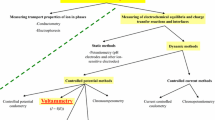Summary
This study investigated the hemodynamic effects of the D-isomer of sotalol in open-chest rats and compared this to the action of the L-isomer and the racemic DL-sotalol. Hemodynamic and additional isovolumic maximum measurements were registered at the end and 5 minutes after an intravenous infusion period of 7 minutes. DL- (1 and 2 mg/kg) and L-sotalol (2 mg/kg) caused a significant reduction in the heart rate and in the indices of contractility during and after infusion. D-sotalol (2, 4, and 8 mg/kg), however, decreased the contractility only transiently after very high doses at high plasma concentrations. Thus, while the effects of the beta-blocking L-isomer were comparable to those of DL-sotalol, only a slight and transient hemodynamic action of comparable doses of D-sotalol was found. These findings may be of significance for the proposed use of the D-isomer as a class-III antiarrhythmic agent.
Similar content being viewed by others
References
Singh BN, Vaughan Williams EM. A third class of antiarrhythmic action. Effects on atrial and ventricular intracellular potentials and other pharmacological actions on cardiac muscle of MJ 1999 and AH 3474. Br J Pharmacol 1970; 39:675–689.
Manley BS, Alexopoulos D, Robinson GJ, Cobbe SM. Subsidiary class III effects of betablockers? A comparison of atenolol, metoprolol, nadolol, oxprenolol and sotalol. Cardiovasc Res 1986;20:705–709.
Singh BN, Deedwania P, Nademanee K, et al. Sotalol. A review of its pharmacokinetic properties and therapeutic use. Drugs 1987;34:311–349.
Josephson MA, Singh BN. Hemodynamic effects of class III antiarrhythmic agents. In: Singh BN, ed. Control of cardiac arrhythmias by lengthening repolarisation. Mount Kisco, NY: Futura Publishing, 1988:153–173.
Parmley WW, Rabinowitz B, Chuck L, et al. Comparative effects of sotalol and propranolol on contractility of papillary muscles and adenyl cyclase activity of myocardial extracts of cat. J Clin Pharmacol 1972;12:127.
Tande PM, Refsum H. Class-III antiarrhythmic action linked with positive inotropy; effects of the d-and l-isomer of sotalol on isolated rat atria at threshold and suprathreshold stimulation. Pharmacol Toxicol 1988;62:272–277.
Kaumann AJ, Olson CB. Temporal relation between longlasting aftercontractions and action potentials in cat papillary muscle. Science 1986;161:293–295.
Mahler F, Ross JJr., O'Rourke RA, Covell JW. Effects of changes in preload, afterload and inotropic state on ejection and isovolumic phase measures of contractility in the conscious dog. Am J Cardiol 1975;35:626–634.
Schmidt HD, Hoppe H, Müller KD. The effect of changes in cardiac frequency on left and right ventricular dP/dtmax at different contractile states of the myocardium. Eur J Appl Physiol 1797;42:183–198.
Hoffmeister HM, Betz R, Fiechtner H, Seipel L. Myocardial effects of inosine. Cardiovasc Res 1987;21:65–71.
Hoffmeister HM, Hepp A, Seipel L. Negative inotropic effect of class-I-antiarrhythmic drugs: Comparison of flecainide with disopyramide and quinidine. Eur Heart J 1987; 8:1126–1132.
Hoffmeister HM, Pflug A, Krämer B, Seipel L. Circulatory and myocardial effects of different sodium antagonistic drugs in comparison to the calcium antagonist verapamil. Drug Res 1989;39(II):1425–1429.
Hoffmeister HM, Storf R, Seipel L. Effects of graded intensity of oxygen deficiency on function and energy metabolism in post-ischaemic myocardium. Cardiovasc Res 1988;22: 881–888.
Wallenstein S, Zucker CL, Fleiss JL. Some statistical methods useful in circulation research. Circ Res 1980;47:1–9.
Touboul P, Atallah G, Kirkorian G, et al. Clinical electrophysiology of intravenous sotalol, a betablocking drug with class III antiarrhythmic properties. Am Heart J 1984; 107:888–895.
Somani P, Watson DL. Antiarrhythmic activity of the dextro- and levorotatory isomers of 4-(2-isopropylamino-1-hydroxy-ethyl) methanesulfonanilide (MJ 1999). J Pharmacol Exp Ther 1968;194:317–325.
Kato R, Ikeda N, Yabek SM, et al. Electrophysiologic effects of the levo- and dextrorotatory isomers of sotalol in isolated cardiac muscle and their in vivo pharmacokinetics. J Am Coll Cardiol 1986;7:116–125.
McComb MJ, McGovern B, McGowan JB, et al. Electrophysiologic effects of d-sotalol in humans. J Am Coll Cardiol 1987;10:211–217.
Burkhardt D, Pfisterer M, Hoffmann A, et al. Effects of the beta-adrenoceptor-blocking agent sotalol on ventricular arrhythmias in patients with chronic ischemic heart disease. Cardiology 1983;70:114–121.
Lynch JJ, Wilbur DJ, Montgomery DG, et al. Antiarrhythmic and antifibrillatory actions of the levo- and dextrorotatory isomers of sotalol. J Cardiovasc Pharmacol 1984;6: 1132–1141.
Lynch JJ, Coskey LA, Montgomery DG, et al. Prevention of ventricular fibrillation by dextrorotatory sotalol in a conscious canine model of sudden coronary death. Am Heart J 1985;109:949.
Driscoll P. The normal rat electrocardiogram. In: Budden R, et al, eds. The rat electrocardiogram in pharmacology and toxicology. Oxford: Pergamon Press, 1981.
Osborne BE. The electrocardiogram of the rat. In: Budden R, et al, eds. The rat electrocardiogram in pharmacology and toxicology. Oxford: Pergamon Press, 1981.
Fitzgerald JD, Wale JL, Austin M. The hemodynamic effects of (±)-propranolol, dextropranolol, oxprenolol, practolol and sotalol in anaesthetised dogs. Eur J Pharmacol 1972;17:123–134.
Mahmarian JJ, Verani MS, Hohmann T, et al. The hemodynamic effects of sotalol and quinidine: Analysis by use of rest and exercise gated radionuclide angiography. Circulation 1987;76:324–331.
Carlsson L, Almgren O, Duker G. Electrophysiologic and hemodynamic evaluation of a novel class-III antiarrhythmic agent, H 234/09, in the anesthetized dog—comparison with quinidine and D-sotalol. Eur Heart J 1990;11:441.
Hoffmeister HM, Seipel L. Vergleich der hämodynamischen Wirkungen von D-Sotalol und D, L-Sotalol. Klin Wochenschr 1988;66:451–454.
Singh SN, Cohen A, Chen Y, et al. Sotalol for refractory sustained ventricular tachycardia and nonfatal cardiac arrest. Am J Cardiol 1988;62:399–402.
Author information
Authors and Affiliations
Rights and permissions
About this article
Cite this article
Hoffmeister, H.M., Beyer, M. & Seipel, L. Hemodynamic effects of the D- and L-isomers of sotalol on normal myocardium. Cardiovasc Drug Ther 5, 1027–1033 (1991). https://doi.org/10.1007/BF00143531
Issue Date:
DOI: https://doi.org/10.1007/BF00143531




